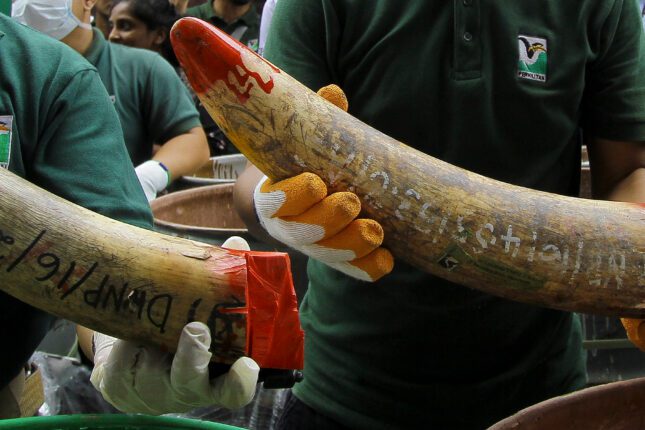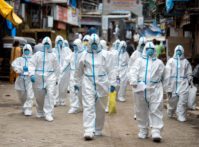-
It’s Time for the World to Treat Wildlife Crime as Serious and Organized Crime
September 2, 2021 By Sophie Le ClueOn August 18, 2021, we witnessed a potential game-changer in the fight against international wildlife crime (IWT). One of the world’s leading wildlife trafficking hubs, Hong Kong, voted to change its laws to treat wildlife Crime as “Organized and Serious Crime.” From 2010 to 2020, local authorities valued wildlife seizures in the city at more than HK$1 billion (USD128.5 million), but the scale of the illicit trade passing through Hong Kong has likely been many times larger.
Why does this matter?
Until relatively recently, the illegal wildlife trade was not considered the existential threat to the world’s biodiversity as it is today, in part due to limited global awareness of the nature and impacts of the trade as well as the lack of government preparedness for its dramatic proliferation. In 1973, the United Nations introduced a legally binding treaty, the Convention on International Trade in Endangered Species of Wild Fauna and Flora (CITES), to “ensure that international trade in specimens of wild animals and plants does not threaten the survival of the species.”
CITES entered into force in 1975 and parties to the convention (to date 183 countries and territories) subsequently enacted national legislation to meet its requirements.
Fast forward to 2021, the wildlife trade has grown dramatically and unexpectedly. In concert, illegal trade has flourished. This illicit trade is substantial, not just in its sheer volume of increasingly rare and endangered species poached and trafficked, but also in its global value, estimated in the region of US$20 billion per year (excluding illegal logging).
Time and again, experts have linked wildlife trafficking to arms, human, and drugs smuggling. Every year more than 150 rangers in Africa and Asia lose their lives guarding animals that become increasingly valuable as their populations decline. Economies and communities—overwhelmingly in developing countries—continue to suffer as precious natural resources are stolen.
Organized Criminals Evade Detection as Seizures Climb
Hong Kong’s port and airport are among the busiest and largest in the world, and both have unwittingly contributed to the IWT crisis. These facilities serve as a gateway to thriving markets in Asia supplying the fashion, traditional medicine, and exotic pet industries with vast quantities of legal and illegal wildlife products.
Hong Kong was slow to acknowledge the city as a trafficking hub, but in 2018, its previous administration enacted legislation to increase penalties for wildlife offenses and phase out the ivory trade. The rise in penalties was substantial, at a maximum of 10 years imprisonment and a HK$10 million fine (US$1.3 million). These penalties were intended to deter wildlife criminals—they did not.
In the three years since, the volume and range of trafficked species have increased and Hong Kong authorities have made multiple record-breaking seizures of totoaba fish maws, pangolin scales, shark fins, and rhino horns. In 2018, 2019, and 2020, Hong Kong’s enforcement authorities seized just shy of 1,000 metric tons (MT) of wildlife in 1,680 seizures, valued conservatively at more than HK$358 million (US$46 million). Thus continuing a decade-long upward trend.
Based on hundreds of court cases, it is clear that those being prosecuted are inconsequential to the organized networks and syndicates behind the large-scale poaching, concealment, and deft navigation of illegal wildlife through the world’s port, airport, and customs authorities.
Most prosecuted in Hong Kong have been caught red-handed arriving at the airport, or receiving products by post. Typically, culprits are on low incomes and are sole breadwinners with multiple dependents. They carry or receive wildlife contraband for small sums of money, with little knowledge of the risks. While these carriers or “mules” are unlikely to reoffend, there are plenty more unsuspecting individuals to recruit from.
Hong Kong’s authorities have repeatedly failed to present sufficient evidence to its Justice Department that would motivate it to prosecute the most significant seizures, usually where contraband is smuggled in shipping containers or air cargo. These include the 2019 seizure of 8.3MT of pangolin scales with 2.1 metric tonnes of ivory, equating to 13,800 pangolins and 200 elephants; 82kg of rhino horn, equivalent 31 black rhino or 14 white rhinos in 2019; 7.2 metric tonnes of ivory in 2017, equivalent to 1,690 elephants; and 1,005 metric tonnes of Malagasy rosewood in 2015.
By incorporating wildlife offenses into its Organized and Serious Crimes Ordinance (OSCO), Hong Kong’s current administration is signaling a change in tactic. It will not let traffickers continue to exploit the city. The Ordinance is the Territory’s primary legislation, providing powers of investigation into organized crimes, as well as providing for the confiscation of proceeds and enhancement of sentencing. By providing access to these powers for wildlife offenses, the government can allocate much needed resources to investigating and prosecuting seizures with complex and illegal supply chains. Notably, mainland China has been cracking down on wildlife trafficking and already imposes harsh penalties with a maximum of life imprisonment for such crimes.
Hong Kong’s performance should now be measured not by the number of seizures or the number of prosecutions, but instead by the capture and punishment of the masterminds and, ultimately, the deterrence of wildlife crime.

Combating Organized Wildlife Crime Needs a Global Mandate
Hong Kong has made a bold step and will be judged by its future actions in bringing the syndicates to justice. The city is however one of several regional trafficking hubs that include mainland China, Singapore, Vietnam, Malaysia, and Thailand. Without multilateral coordinated action, it is likely trafficking in Hong Kong will simply shift to alternate routes that are less risky.
The United Nations has repeatedly called on its member states to do more to combat wildlife trafficking. It has adopted five such resolutions since 2015, the most recent in July 2021. This latest resolution urges member states to take decisive steps to prevent, combat, and eradicate the illegal trade in wildlife, including strengthening local legislation. In particular, it encourages states to make trafficking in protected species of wild fauna and flora involving organized criminal groups a serious crime.
The Global Initiative to End Wildlife Crime has gone a step further and is calling on the United Nations to include wildlife trafficking in the UN Convention against Transnational Organized Crime (UNTOC). The UN General Assembly adopted the UNTOC, also known as the Palermo Protocol, in 2000 and it came into force in 2003. It has 190 parties and is a legally binding treaty aimed at fostering international cooperation between law enforcement and the judiciary in the pursuit of international criminals. Importantly, it provides a framework for member states to create criminal offenses in their domestic legislation to enhance investigation and prosecutions. It further promotes training and technical assistance for building capacity. Hong Kong’s implementing legislation is its Organized and Serious Crimes Ordinance.
Currently UNTOC relates specifically to trafficking in persons, migrants, and arms, via three separate protocols. A fourth protocol on wildlife trafficking would make sense. It could facilitate jurisdictions to treat wildlife crimes as serious and organized—as Hong Kong has just done.
If such a fourth protocol was adopted and effectively enforced across jurisdictions, there is hope that the decreasing numbers of trafficked species’ populations can be slowed, benefiting not just biodiversity and economies, but importantly animal and public health, worldwide.
Sophie Le Clue is responsible for environmental investments including the identification/evaluation of projects and aligning financial investment with strategic philanthropic objectives at ADM Capital Foundation based in Hong Kong. In this capacity, she has a specific focus on the Foundation’s marine and wildlife trade portfolio and strategy. Sophie has worked for the past 28 years in the field of environmental protection and conservation, principally in the Asia Pacific region. Sources: ADM Capital Foundation, Convention on Biological Diversity, Endwildlifecrime.org, Government of Hong Kong Special Administrative Region, Hong Kong Customs and Excise Department, News.gov.hk, United Nations, World Bank. Lead Photo Credit: Staff at a government-run waste management facility outside Seremban, Malaysia arrange seized ivory tusks before destroying, courtesy of MIFAS/Shutterstock.com.
 A Publication of the Stimson Center.
A Publication of the Stimson Center.







